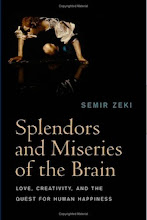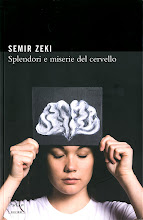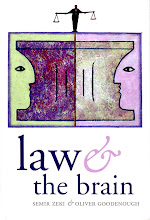I describe briefly a new and hitherto
undocumented phobia, which I shall name neurophobia
and those who display it as neurophobes.
It is a somewhat new phobia, perhaps no more than 15 years old but it shares
characteristics with other phobias. It is to be distinguished from the neurophobia that medical students apparently suffer from when studying neurology.
Neurophobia can be defined as a profound dislike, with various degrees of
severity, for cognitive neurobiology and especially for neuroesthetics and for
what these disciplines promise to show us.
Neurophobes are a motley crowd and, as with so many other phobias, they include
people from different backgrounds and walks of life – philosophers of different
degrees of eminence, humanists, religionists and even (surprisingly) some
neurobiologists. This is not to say that all philosophers and humanists are
neurophobes, far from it; many are interested and excited by the discoveries
that neurobiology and neuroesthetics have to offer, but neurophobes are more
vocal. Nor are all religionists neurophobes: I have had some very interesting
discussions with some religionists, who have shown themselves to be hospitable
to new ideas. Interestingly, I have not encountered neurophobia among artists
(yet), which again does not mean that there aren’t neurophobes among them. Hence,
neurophobia, like other phobias, cannot be associated with any particular
grouping, either socio-economic, cultural or otherwise.
Among the characteristics of neurophobia,
one may list the following:
1. An irrational fear: they invest
neuroesthetics in particular with imaginary powers; these include weapons of
mass destruction (WMD), for how else to interpret a statement that neuroesthetics
“… will flatten all the complexity of culture, and the beauty of it as well”?
and other similar statements.
2. A desire to find a place for the mind
outside the brain, not perhaps realizing that cognitive neurobiology and
neuroesthetics study neural mechanisms and hence the brain, and that their
conclusions are to be seen in that context.
3. The use of emotionally charged and
pejorative terms to dismiss neuroesthetics, terms such as “trash”, “buncombe”,
“rubbish” and others like them, which have no place, or should have no place,
in scholarly (and especially scientific) discourse. Hence neurophobia shares a
similarity with other phobias in that it is not easy to rationalize it
cognitively, an appeal to emotional and pejorative language being the only way
out.
4. The pursuit of ignorance: As with so
many other phobias, this amounts to the wish not to know. Hence, neurophobes
don’t want any scientific ‘de-mystification’, which they would regard as a
“desecration” (note again the emotive language) and prefer to live in
ignorance. This is of course similar to other prejudices, where ignorance is
the preferred course.
5. This arrogance displays itself in their
protecting themselves against the facts. As I have said before, once they
relegate our discipline to the status of “trash”, they need not bother with it.
And there is, in their writings, good evidence that they have not read what we
have written.
6. Arrogance of ignorance: neurophobes
always assume that they know better, and hence lecture us on what they suppose
we are not aware of. They never cease to tell us that art and beauty are not
the same, as if we are not aware of that and have not written about it. They
never cease to emphasize the importance of culture and learning in aesthetic
appreciation, as if this is a new insight that we are not aware of.
7. Attack the methods: where all else
fails, there is always recourse to attacking our methodology – principally the imaging
techniques. They fault these for their spatial and temporal resolution
(sometimes using emotive language) as if we are not aware of these shortcomings
and do not take account of them in our interpretations. (I will have more to
say about this in a future post.) I imagine most are scared of new technologies
that will have greater powers of resolution.
This collection of characteristics is very
descriptive of neurophobia, and they are interlinked. Hence if one detects one
of these characteristics in an individual, one must suspect him/her of being a
neurophobe and display the other
characteristics on gentle probing. Here I would advise caution; it is best to
probe a little further before classifying someone as a neurophobe.
Of course, many of them preface their pejorative remarks with feint praise, such as "Neurology has made important advances" (rather like, some of my best friends are neurologists).
And finally…what one neurophobe says or
writes is remarkably similar to what another one says or writes, reminding me
of the famous line of President Reagan, “There you go again”. Indeed, so
similar are their articles that it becomes reminiscent of another one of
Reagan’s famous lines (about redwood trees): “Once you’ve seen one, you’ve seen them all”.









 Contact us
Contact us